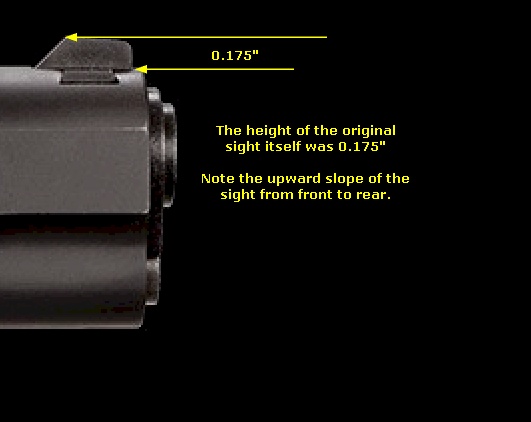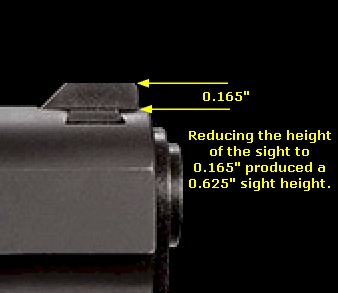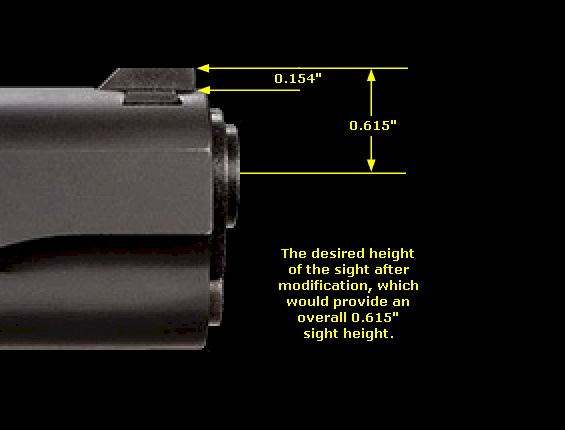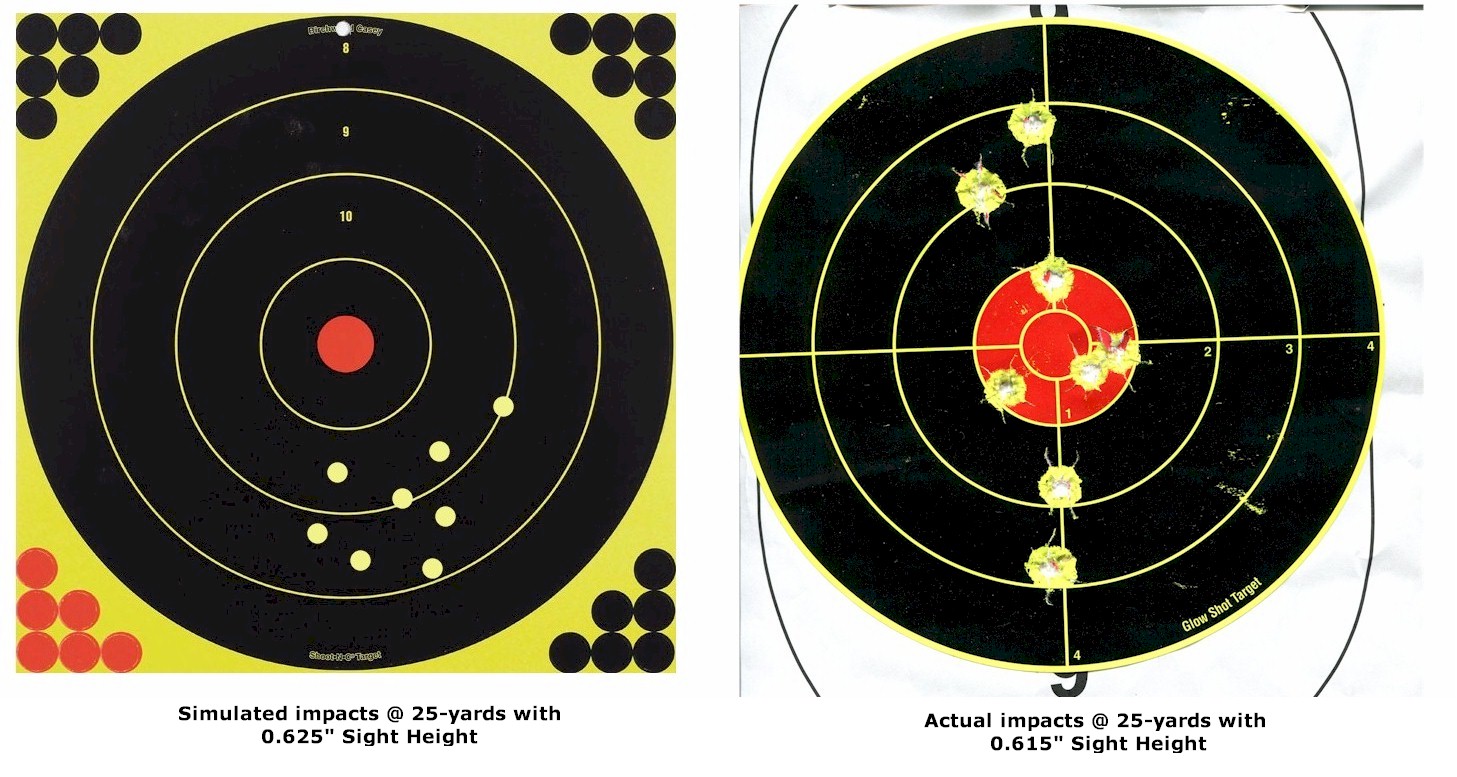When Working the (Trajectory) Angles?” (Projectile Dysfunction) was first published, I did not intend for the theme to become a project. It has since become a project because I needed to put theory to the test.
Part 2 of “Working the (Trajectory) Angles?” brought to the forefront an issue with my Rock Island Armory FS 1911 Tactical in regards to zero and the sight height of the pistol. I felt that writing a third part would convey the results of the actual work done on the pistol.
To take you back a bit to “Working the (Trajectory) Angles? – Part 2” I presented some cartridge ballistic information based on the current front sight height of the Rock Island Armory FS 1911 Tactical, where the rounds were actually impacting the target at twenty-five yards (at about 1.5” low from POA), and where I desired the rounds to actually impact at twenty-five yards, which was my zero point.
I noted that in order to get the rounds to my POA at twenty-five yards, I needed to lower my front sight height and also presented the equation that I used to figure out how much to lower the front sight.
Sight Change = Sight radius x Impact distance/Target distance.
Where:
Sight radius: Distance between front and rear sight
Impact distance: Measurement from point of aim to bullet impact
Target distance: Measurement from muzzle to target
Sight change: Amount of correction needed
The ballistic information, from GunData.org, based on a new sight height of 0.615-inches, is shown below:
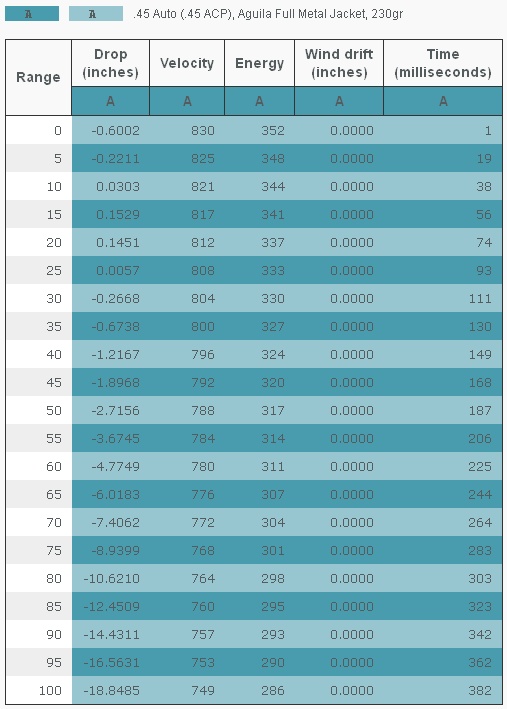 Calculated 25-yard Zero with 0.615″ Sight Height
Calculated 25-yard Zero with 0.615″ Sight Height
As you can tell from ballistic data, the sight height of 0.615″ would work out very well for me; it produces a relatively flat trajectory out to my “zero” at twenty-five yards and there is very little guessing where to place my POA at that distance. At greater distances, and knowing what is expected out of the cartridge, I can quickly adjust for holdover out to fifty yards (≈ 2.8”). At seventy yards, and if I do my part, bullets should be able to contact the target within my 8-inch “Magic Window” by adjusting my POA to the correct amount of holdover (≈ 7.5”). Obviously, I will not be able to hold to those exact figures, but they do suggest that I can hold within “Combat Accuracy” if I use those figures as a guideline.
THE WORK PROGRESSIVE
The easiest method was to simply measure from the top of the base on the sight to the top of the sight at the highest point. The measurement of such revealed that the original sight was 0.175-inch from base to tip.
Again, and after the initial filing, the easiest method to determine the height of the actual sight was to simply measure from the top of the base on the sight to the top of the sight at the highest point.
I removed the uppermost tip and simply leveled the top of the sight to the bore axis of the pistol as best I could. The measurement of such revealed that the sight was approximately 0.165-inch. In essence, I had removed 0.010-inches of the front sight with the first attempt at reducing the height of the sight itself.
To some, the response might be, “Dude! That is a lot of material!” I would agree. However, the front sight on the Rock Island Armory 1911 (Tactical) models is sloped upward at the rear of the sight. As a comparison, the compact model, measured out at 0.132-inch. The front sight that is installed on the Rock Island Armory CS 1911 is actually 0.043 of an inch lower than the 0.175-inch sight that was installed on the Rock Island Armory FS 1911 Tactical, yet they are both chambered in .45 ACP. However, the distance from the center of the bore to the top of the slide on both pistols is the same; 0.465-inches. The Rock Island Armory CS 1911 was simply manufactured with a shorter front sight. The Rock Island Armory CS 1911 shoots POA at fifteen yards; the Rock Island Armory FS 1911 Tactical shoots low at fifteen yards. A lower front sight height definitely makes a difference.
Essentially, I had to shave an additional 0.010” of material off the front sight to get the sight height down from the first attempt at 0.625-inch to the desired 0.615-inch sight height.
It must be noted that getting an exact sight height measurement is extremely difficult without a precision sight-height gauge and sight-height gauges can run into hundreds of dollars in cost. It is extremely difficult, if not impossible, to detect 0.01” of change with the naked eye. Regardless of any and all measurements and I was simply working with a digital caliper (with a tolerance of +/- 0.001”) to indicate measurements. I am not a precision machinist, let alone a general machinist, or even a gun smith, and this project wasn’t even close to rocket science.
A number of passes with a fine file soon reduced the top of the sight by 0.010” in reference to the base, which brings the actual sight height down to 0.154”, and which will provide an overall 0.615-inch sight height. The approximate sight height of the Rock Island Armory CS 1911 is 0.589-inches. That is only a difference of 0.026-inches relative to the pistol’s current 0.615” sight height and is really nothing to be concerned with in the overall scheme of things.
In essence, I had removed approximately 0.021-inches of material from the top of the sight itself to (hopefully) raise the impact of my bullets 1.5” on the target.
The real test of theory vs. reality; however, was to shoot the darn pistol using the selected Aguilla 230-grain FMJ (1E452110) ammunition at my desired zero distance of twenty-five yards and then evaluate the results.
RANGE DAY
 It was time to pit theory against reality. All of these numbers that I have thrown at you in this article, and past related articles, was simply theory at work. The theory; however, was founded in the result of calculations that were provided to me and which provided, at least, a place to start in correcting the POA-to-POI issue with the Rock Island Armory FS 1911 Tactical.
It was time to pit theory against reality. All of these numbers that I have thrown at you in this article, and past related articles, was simply theory at work. The theory; however, was founded in the result of calculations that were provided to me and which provided, at least, a place to start in correcting the POA-to-POI issue with the Rock Island Armory FS 1911 Tactical.
The Rock Island Armory FS 1911 Tactical would be bench-rested and would be loaded with the same ammunition as at the start of this endeavor, Aguilla 230-grain FMJ. My evaluation would be based on what happened at ten-yards and then at twenty-five yards (my desired zero distance) if the ten-yard evaluation was within my expectations. The bottom line was that the results of the test would meet my expectations or not; it is as simple as that. Two magazines of eight rounds each was to be used; one magazine full at ten yards and the second at twenty-five yards. It was time to fish or cut bait, as they say. I approached the firing table with both anticipation and anxiety at the same time.
To cut things short, I was pleased with the results at ten-yards, slapped on a Shoot-n-See target, and moved the target to twenty-five yards.
I didn’t have a record of what the bullet impacts were at twenty-five yards prior to the sight height correction so below is a depiction of somewhat where the rounds were impacting with the previous sight height of. 0.625-inches, with the point of aim as close the “X” as I could get it, as compared to the actual bench-rested impacts with the sight height now at 0.615-inches. The target is eight-inches in diameter. The POI is virtually at the POA with all else considered (like trying to line up a red front sight with the center of the red in the bulls-eye of the target and using my 10 MOA trigger finger). This is more like what I was looking for!
THE AFTERMATH, or SHOULD I SAY THE MATH AFTER!
It certainly has been a journey getting things this far, and I received an education to boot! All the research in cartridges, bullet trajectories, sight adjustment calculations, doing the actual work, and seeing the results actually proving that the theory was sound, is very satisfying to me.
Even though I have thrown out a lot of precise figures during this series of articles, I knew that if I could get “close enough for government work” with my 10 MOA trigger finger pulling on the trigger of an inexpensive 1911-based pistol, that had previously shot very low in relation to the POA, I was in the ball game.
Thankfully, there is no “back to the drawing board” time for me; I can put all of this math in the past, but have it available to me when I need it in the future. Perhaps, you can use it as well?
THE PARTING SHOT
I have brought you this far in my journey that was initially intended to be presented in one part. It somehow grew a life of its own, and I hope that you have read the series through thus far.
I have taken you from barrel to a bullet’s path in as simple terms as I could muster (I’m fairly simple-minded myself), but the journey is still not over and there is one more short bit to go, and that is the bullet and the target. I hope that you can make it to “Working the (Trajectory) Angles? – Part 4 (Stopping the threat!)” and complete the journey with me.
The Rock Island Armory FS 1911 Tactical took some work to get it “Combat” ready and is just not a pistol that I take to the range to shoot on occasion. A Wolf #18 recoil spring has been installed and the extractor tuned to the correct tension. The last item on the menu was to get it sighted in for my desired “working” distance and that has been what this series has been about. When I slide it in the SHTF IWB Holster (now Black Rock Holsters) and carry it as my EDC, I don’t need any trepidation about using it should that time ever come. I have done everything to it that I can to make it operate properly in my hands; the rest is up to me.
I do have to mention that the sights on my Rock Island Armory FS 1911 Tactical may be different than those found on your particular pistol. I had to line the top of the front sight with the top of the rear sight; you may be aligning dots. Regardless, sight height is determined by where your sights align and not what type of sight that you have. Had this pistol been equipped with dot sights, my measurements would have been to the center of the dots and not to the top of the sights.
Now, I have to decide whether to keep the existing front sight or order a front sight of my choosing and to the height that I need to maintain my work. I painted the top of the front sight, where the filing was done, and it really does not look that bad in a dark grey and it protects the front sight from corrosion. Work is never fully completed – sigh!
Join me in Part 4 – Working the (Trajectory) Angles? – Part 4 (Stopping the threat!)
RESOURCES
- GunData.org: http://gundata.org/ballistic-calculator/
- Working the (Trajectory) Angles? – Part 1 (Projectile Dysfunction): https://guntoters.com/blog/2016/08/02/working-the-trajectory-angles/
- Working the (Trajectory) Angles? – Part 2 (More Projectile Dysfunction): https://guntoters.com/blog/2016/08/02/working-the-trajectory-angles-part-2/
![]()



